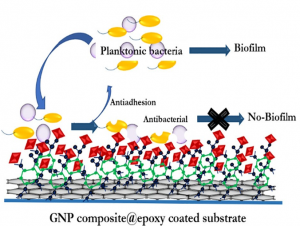New Nano-Composite to Beat Antimicrobial Resistance
The battle against antimicrobial resistance is set to get a major boost with researchers from the Indian Institute of Technology (IIT)-Roorkee and Bengaluru-based startup Log 9 Materials Scientific Pvt. Ltd., developing a new non-toxic antibacterial and antibiofilm composite.
Institute of Technology (IIT)-Roorkee and Bengaluru-based startup Log 9 Materials Scientific Pvt. Ltd., developing a new non-toxic antibacterial and antibiofilm composite.
Bacterial biofilms are notorious for resisting antibiotics, escaping immune systems, and other external stresses, resulting in persistent chronic infections, particularly when formed in damp indoor settings. Biofilms pose a serious global health concern.
Formed when different colonies or even a single type of bacterial cells adhere to biotic or abiotic surfaces, they get embedded in a matrix composed of extracellular polymeric substances. Biofilms form on different surfaces including hospital surfaces, healthcare implants, swimming pools, water tanks, and water treatment plants, and hence easily transmit infections. Of these, hospital-acquired infections are the most dangerous as observed by the extremely high incidence of multidrug-resistant bacterial illnesses in hospital settings.
Also Read : Char Dham: The Road to Environmental Concerns
Studies have shown that nanomaterials with their unique physicochemical and antibacterial properties can break the chain of microbe proliferation, preventing biofilm formations via diverse mechanisms. But for human use, such nanomaterials need to be non-toxic.
Researchers from IIT Roorkee and Log 9 Materials Scientific Private Limited, which is funded under the Department of Biotechnology’s Bengaluru-based Centre for Cellular and Molecular Platforms (C-CAMP)’s Biotech Ignition Grant scheme, have now developed an antibacterial and antibiofilm composite using non-toxic and hydrophobic nanomaterial, graphene nanoplatelets (GNP), and tannic acid and silver. When tested, it exhibited good antibacterial properties.
According to the scientists, it showed complete growth inhibition against gram-negative bacteria, Escherichia coli at a concentration as low as 64 μg/mL while it showed complete inhibition against gram-positive bacteria, Staphylococcus aureus at a concentration of 128 μg/mL. When epoxy coatings based on the material were applied on glass substrates, more than 97% antibiofilm efficiency was seen against the antibiotic-resistant, Methicillin strain of S. aureus.
When coated on a surface, the abundant presence of hydroxyl groups due to tannic acid, hydrophobicity of graphene and epoxy, and remarkable antibacterial efficiency of tannic acid, silver, and graphene was found to synergistically enhance the antibiofilm efficiency. Additionally, this coating was found to be highly stable in water, the common solvent most surfaces come in contact with, and no active component was found to be leaching out. (Indian Science Wire)
